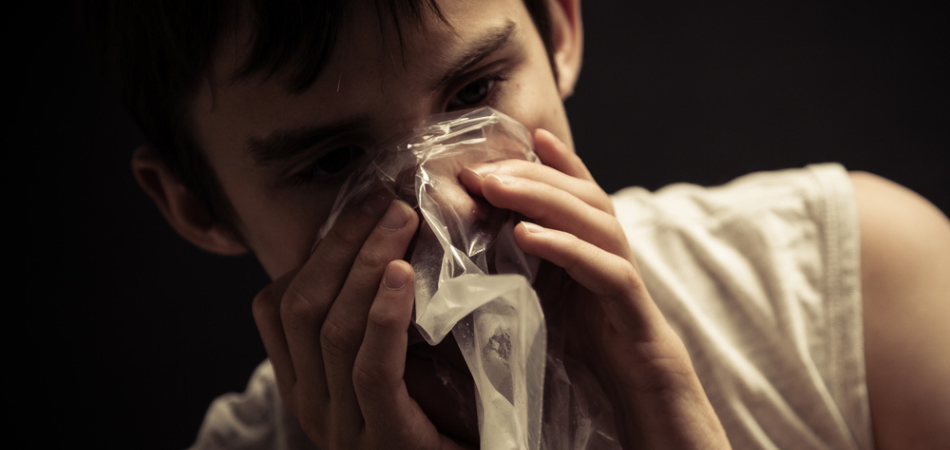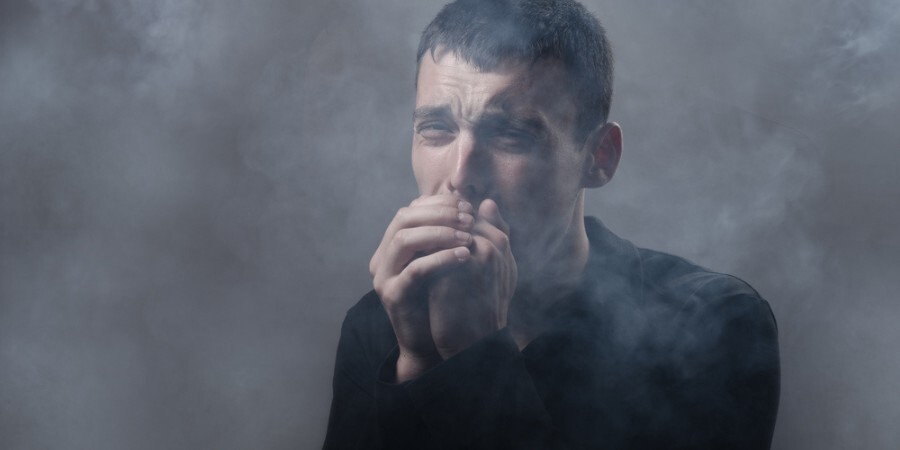Last Updated:
August 1st, 2025
Inhalants Addiction | Symptoms, Effects and Causes
What are inhalants?
Inhalants are substances that produce chemical vapours that can be inhaled to induce mind-altering effects. They are often found in everyday household products or industrial chemicals, making them easily accessible but highly dangerous.
Unlike other drugs, inhalants are not consumed by swallowing, smoking or injecting; Instead, they are taken by inhaling the fumes, a method commonly referred to as “huffing.” Some users may trap and inhale the fumes in plastic bags or balloons.
The method allows the chemicals to rapidly enter the bloodstream, leading to an almost immediate high, albeit short-lived.

Why do people take inhalants?
People often misuse inhalants for the quick, euphoric effects they produce. This may include feelings of light-headedness, relaxation and distorted perception. Unfortunately, the accessibility of inhalants makes them especially appealing to younger individuals or those without access to other substances.
Six commonly abused inhalants
- Glue: Adhesive products like glue are often misused for their solvent content, which produces a strong high when inhaled. Prolonged misuse can damage the brain, liver and kidneys.
- Paint thinners: Commonly found in hardware stores, paint thinners contain toluene, a substance that affects the central nervous system and can cause dizziness, hallucinations and, over time, permanent nerve damage.
- Nitrous oxide (laughing gas): Used medically as an anaesthetic, nitrous oxide is often inhaled recreationally from whipped cream chargers or balloons. While it can produce euphoria, its misuse can lead to oxygen deprivation and nerve damage.
- Gasoline: Inhalation of gasoline vapours is not only addictive but also highly toxic. The fumes affect the brain and heart and can cause severe organ damage or death from cardiac arrest.
- Air fresheners: Aerosol air fresheners contain chemicals like butane and propane. Misuse can lead to immediate damage to the lungs and respiratory system, as well as long-term brain damage.
- Marker pens (solvent-based): Solvent-based markers are misused for the chemicals in their ink. These substances can cause dizziness and a sense of euphoria but they are also linked to memory loss and cognitive impairment over time.
Struggling with an addiction? If you are ready to seek help, reach out to us today, and a member of our compassionate team will help you find the best option for starting your recovery journey.
The rise of Nitrous Oxide in the UK
Nitrous oxide, commonly known as laughing gas, has seen a rise in both prevalence and associated risks in recent years. While deaths directly linked to nitrous oxide are rare, the numbers are steadily increasing, raising alarms about its potential dangers. According to data from 2021/22, approximately 1.3% of adults in England and Wales—around 440,000 people—reported using nitrous oxide, highlighting its popularity, particularly among younger demographics.
This surge in usage prompted the UK government to re-evaluate its stance on nitrous oxide. In November 2023, the substance was reclassified as a Class C drug, reflecting its growing association with health and societal concerns. This decision marks a shift in recognising nitrous oxide as more than just a recreational “party drug.” Its misuse can lead to severe health risks, including nerve damage, cognitive impairment and, in rare cases, fatality.
Can inhalant use become addictive?
Inhalant use can indeed become addictive, though the nature of this addiction often differs from other substances. Due to their accessibility, inhalants are sometimes underestimated in terms of risk, but repeated use can result in a strong psychological dependence. Individuals may find themselves craving the effects or feeling unable to stop using, even when they recognise the harm it causes.
While inhalant addiction is primarily psychological, some physical withdrawal symptoms, such as headaches, nausea or irritability, can occur when use is discontinued. The risk of addiction depends on factors such as frequency of use, the specific inhalant involved and individual vulnerability. Understanding these risks is essential to addressing harmful use patterns and seeking support when needed.
What are the signs of inhalant addiction?
Recognising the signs of inhalant addiction is crucial for protecting yourself or a loved one from the harmful effects of these substances. Because inhalants are often easily accessible, addiction can develop quickly, and the warning signs might not always be immediately clear. Understanding these behavioural, physical and psychological indicators can help identify a problem early, making intervention and support more effective.
- Frequent use of household products: Using common items like glue, paint thinner or aerosols outside of their intended purposes may indicate addiction.
- Hiding inhalant paraphernalia: Keeping items like rags, paper bags or empty cans in hidden places often points to secretive use.
- Neglecting responsibilities: School, work, or personal obligations may take a back seat as inhalants become a priority.
- Chemical-smelling breath or clothing: A distinct, often sweet chemical odour can linger after inhalant use.
- Red or runny nose: Irritation around the nose and mouth is common due to frequent exposure to harsh chemicals.
- Frequent headaches: Inhalants reduce oxygen flow to the brain, often causing persistent headaches.
- Loss of coordination: Dizziness or clumsiness can result from the disorienting effects of inhalants on the nervous system.
- Sudden mood swings: The short-lived effects of inhalants can cause rapid emotional shifts, including irritability or euphoria.
- Memory problems: Chronic inhalant use can impair cognitive function, leading to forgetfulness or confusion.
- Paranoia or hallucinations: Some inhalants alter perception, causing feelings of suspicion or distorted reality.
- Cravings for inhalants: A persistent desire to use inhalants despite knowing the harm indicates psychological dependence.
- Withdrawal symptoms: Anxiety, restlessness or agitation when not using inhalants suggests dependency.
Do I have an inhalant addiction?
Determining whether substance use has developed into an addiction can sometimes be challenging due to its complex nature. Below are five questions to help you reflect. If you answer ‘yes’ to any of these, it may indicate an addiction to inhalants and the need for professional support.
- Have you noticed an increasing need to use inhalants to feel the same effects as before?
- Do you find it difficult to stop using inhalants, even when you try?
- Have inhalants started interfering with your work, school or personal relationships?
- Have you experienced withdrawal symptoms, such as headaches or mood swings, when not using inhalants?
- Have loved ones expressed concern about your use of inhalants or its effects on your health and behaviour?

If these questions resonate with you or someone you care about, it may be time to explore support options. Recognising the problem is the first step towards finding a solution.
How is an inhalant addiction treated?
Overcoming inhalant addiction requires a comprehensive treatment approach that addresses the physical, emotional and psychological aspects of dependency. The process typically begins with an assessment to understand the severity of the addiction and create a personalised treatment plan.
Detoxification is often the first step, allowing the body to clear itself of harmful substances. Professional support during detox is crucial to manage withdrawal symptoms and ensure safety.
Therapy forms the foundation of recovery, helping individuals explore the root causes of addiction and develop healthier coping mechanisms. Common approaches include cognitive-behavioural therapy (CBT), one-to-one counselling and group therapy. Holistic treatments such as yoga, art therapy or mindfulness can also aid emotional healing.
Aftercare is essential for long-term recovery, offering ongoing support through follow-up therapy or support groups to reduce the risk of relapse.
Seeking professional help from an accredited rehab centre is a vital step toward a healthier future.
Our compassionate team are ready and available to take your call, and guide you towards lasting the lasting addiction recovery you deserve.
Frequently Asked Questions
(Click here to see works cited)
- Nitrous Oxide Becomes a Class C Drug, commonslibrary.parliament.uk/nitrous-oxide-no-laughing-matter/. Accessed 6 Jan. 2025.

